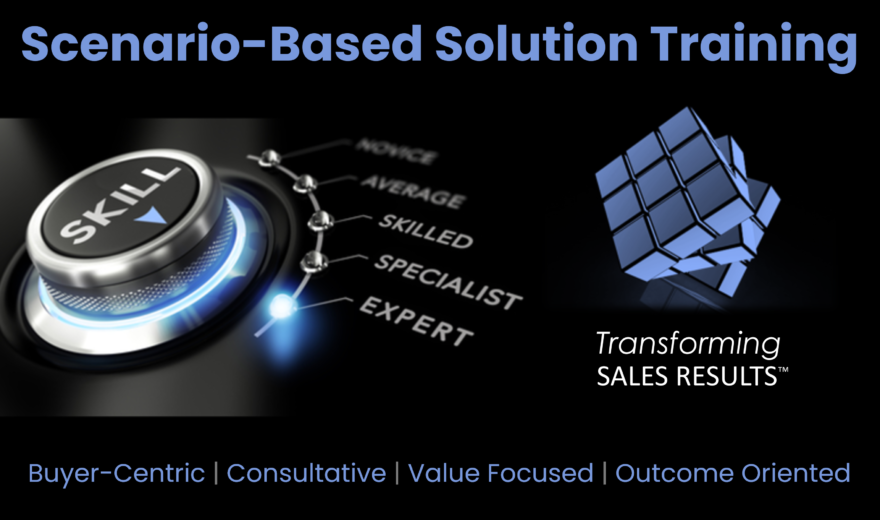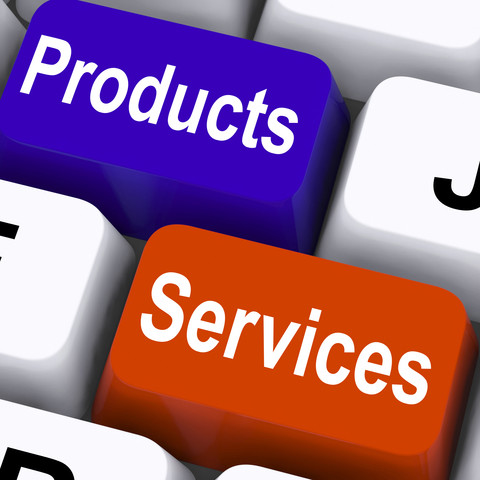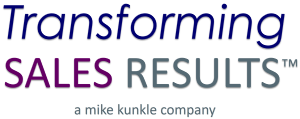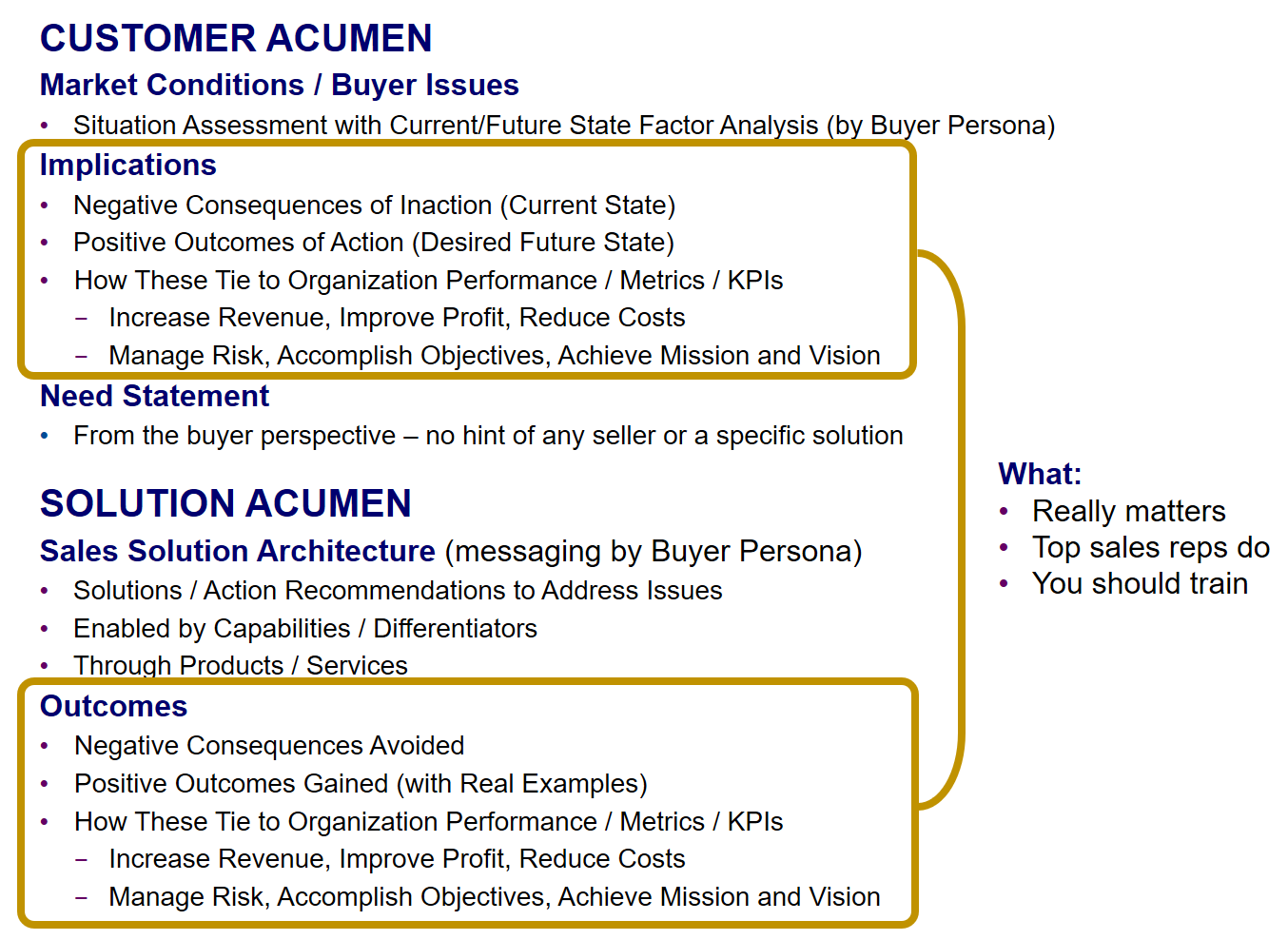Stop Product Training – Do Scenario-Based Solution Training Instead!

I’ll admit it, right upfront. There’s no doubt that sales professionals need to understand their products and services. This is a given. Product training is necessary. What troubles me, despite how much has been written on this topic, is that so many companies are still not maximizing the potential of their product training efforts to get beyond product knowledge to the real crux of how to sell solutions effectively.
I could go back much further or cite other more recent sources, but as just one example, in one of their CSO Insights’ Sales Performance Optimization Studies, Jim Dickie and Barry Trailer wrote:
“…while product training will always be needed, Level 4 [the best-performing] companies realize that prospects typically conduct significant online research before meeting with a salesperson, and, as a result, are no longer reliant on the salesperson for information. So, the primary focus of these companies’ training initiatives is on improving the selling skills of their salespeople, so that they can have meaningful business dialogues with prospects.”
I’ll offer other related reading at the end of this post, but the rest of this post will be dedicated to one method that has produced great results for me. I call it Scenario-Based Solution Training.
Disclaimer: Rarely does one set of advice apply universally, so as always, read this with your situation and nuances in mind. Some product or services and their related features and benefits are very complex. Apply any advice, including mine, with reason and good judgment based on the context and nuance in your situation.
Scenario-Based Solution Training
How to Think About Your Products and Services
My first advice? It’s how you think about your offerings. Here’s the tiering and terms that I like. You may use or prefer other terms and I rarely feel the need to debate semantics. Most importantly, follow the concepts and the logic bread-crumb trail, and call things whatever you want.
- You have a product or service (which I’ll call “product” for simplicity).
- Your product has features which are factual characteristics.
- The way a feature works or what it does is the advantage. (A feature may provide a competitive advantage over other similar products).
- A feature and its advantage (and competitive advantage, when existent) provide a benefit to customers by addressing an issue for them — usually by avoiding a negative impacts (avoiding something bad) or enabling an opportunity or positive impact (getting something good).
- A benefit produces a business outcome — a result.
- The outcome translates into business value — impacting the metrics that matter for the business and the way that the buyers/decision-makers are measured (value may include things other than financial, such as the achievement of mission or vision, but is very compelling when dollarized) — this is the ROI.
- Multiple features/advantages/benefits combine into your company’s capabilities; the competitive advantages, when they exist, become your differentiators.
- The way you combine these capabilities to address business issues for your clients become your solutions.
Let that sink in. It may be overkill for some simple situations, but again, the important thing here is the thought process, starting at the top and flowing to tie impacts to outcomes that provide business value.
I’m hoping that you already see that this goes far beyond “product knowledge” or typical “product training,” and foreshadows where I’m heading with Scenario-Based Solution Training.
One addition: I’m talking about products here, but I’d be remiss if I didn’t reinforce that people are often a true competitive advantage. The way in which you work with your customers, implement a solution, deliver customer support, or engage your sales engineers, may all provide real advantages to your customers. And of course, there’s you. Relationships and trust still matter a great deal. Just don’t expect them to always overpower compelling financial or performance value. If you believe these advantages hold true for you, you should try to quantify them in the above framework.
How to Deliver Better Product Training
1. How Your Products Work
As you can probably guess by now, I think that having basic product knowledge is simply the ticket for entry. It’s a prerequisite. While product complexity varies, for the most part, this is basic knowledge acquisition.
You can use elearning, videos, reading, virtual instructor-led training (vILT), learning games, or mix-and-match blended solutions to lay this foundation. Using assessments to confirm understanding and sustain the knowledge gained over time is also a smart idea. For the instructional design geeks in the house, this employs both spaced repetition and retrieval learning. Since selecting the right training approach this isn’t the real purpose for this post, I’ve listed additional resources in Related Reading.
The first step here is to help your sales reps understand your products and how they work. Unfortunately, this is often the first and last step in many product training programs, but you won’t allow that to happen. In this stage, teach the generic, factual things about your products:
- Features
- Advantages
- Competitive advantages
2. What Your Products Do for Customers
After the foundation of facts, it’s time to switch gears and focus externally. Since Benefits are always specific to a customer, I leave those until this stage:
- Benefits
- Outcomes
- Value
Here, the training requires examples (and again for the instructional design geeks, some non-examples – or when the products don’t fit a customer situation). Teaching Benefits, Outcomes and Value ties to domain expertise as well as business and financial acumen, so those competencies are a prerequisite. Your reps either need to bring those skills to the table, or they need to be a prerequisite in your curriculum.
3. How to Develop Solutions
This is where the scenarios come in. Now we’re going to focus on:
- Capabilities
- Differentiators
- Solutions
To save me from re-writing it here, it’d be helpful to check out this post on insight selling, or at least this graphic:
This is the place to pull in your market knowledge of the challenges and opportunities your buyers face, buyer personas, and the things discussed in this post/chart. It’s also the place to pull in deeper specifics about customer scenarios.
In this portion of the training, you should create various real-world customer scenarios and use case studies. When reps dig into them, they should uncover ways to address their issues with your solutions. The first few should be easy and cut-and-dried. They should get progressively less clear and more challenging, simulating whatever complexity your customers and reps face in the real-world. In many case, you can use real situations that your sales team has faced. There’s some great potential here to engage top reps (in person or video) and customers (via video), in your training, as well as Win/Loss analysis and Voice of the Customer data. In some cases, you may need to develop real-worldly but simulated scenarios, to help your reps connect the dots you want to highlight or reinforce, based on what you’re training at the time.
In my opinion, despite my fondness for elearning and vILT (done well), I still believe this is best done in a classroom setting, when possible. This is more sales training than product training, and while vILT technology is advancing, classroom ILT is still often the best medium for diving into case studies, having deep discussions/debating options, participating in breakouts or group activities and individual assignments followed by group discussion, troubleshooting, and simulations. If you’re doing a bootcamp, or if this is part of your sales onboarding, there’s a wonderful opportunity to incorporate your training on sales messaging, as well. No matter which option you choose, remember that event-based training doesn’t work for product training or sales training, and support your efforts with an effective sales learning system.
Product Mastery Rubric
I’ve used a product mastery rubric for years that pulls together many of these elements and others, after the basic product mechanics (how it works) are understood. This is how you truly prepare your sales force to sell solutions in a way that matters to buyers. (Click the image to view a larger version.)

Note: Some of the concepts in the matrix (COIN-OP, Value Drivers, POSE) are from Modern Sales Foundations (MSF), which I co-authored at SPARXiQ. MSF is a buyer-centric, consultative selling sales methodology and training program that is both value-focused and outcome-oriented. You can learn more here.
___________________________
That’s it for this post on Scenario-Based Solution Training. As usual, this is what I think. More importantly… What do YOU think?
I’d enjoy hearing your thoughts in the comments and your experiences with this method or others. I’ve also included some related reading below, that I hope you’ll find helpful.
As always, thanks for reading, be safe out there, and by all means… let’s continue to elevate our sales profession.
Mike Kunkle
Follow my work and connect:
- SPARXiQ Blog: https://sparxiq.com/author/mikekunkle
- The Building Blocks of Sales Enablement Book: https://bit.ly/BBofSE
- Sales Effectiveness Straight Talk Webinars: https://bit.ly/MikeKunkle-OnDemand (60 Free Recorded Webinars)
- Mike’s LinkedIn Articles: http://bit.ly/MK-LinkedInArticles
- Mike’s LinkedIn Profile: https://www.linkedin.com/in/mikekunkle
- Mike on Twitter: https://twitter.com/mike_kunkle
Related Reading:
On Product Training
- http://www.admarco.net/inbound-marketing-messaging-sales-performance-blog/bid/61436/Product-Training-Doesn-t-Work-Get-Sales-to-DO-Product-Training
- http://www.rainsalestraining.com/blog/product-knowledge-training/
- http://archive.constantcontact.com/fs139/1101302425732/archive/1112612659191.html
On Features/Benefits
- http://www.sellingpower.com/content/article/?a=8554/understanding-feature–advantage–benefit
- http://www.salesreadinessgroup.com/blog/bid/324623/One-of-the-Worsts-Mistakes-Even-Highly-Experienced-Salespeople-Make
On Sales Training Systems
- https://sparxiq.com/ebook-sales-training-that-sticks/
- https://www.linkedin.com/pulse/20140914192639-834966-how-to-build-a-blended-sales-training-curriculum
- https://www.mikekunkle.com/2017/03/14/transform-your-sales-results-with-a-systems-approach-part-4-sales-learning/
On Selecting the Right Training Method
- http://www.nwlink.com/~donclark/hrd/isd/deliversys.html (Don’s entire site rocks)
- http://thetrainingworld.com/faq/indexmethods.htm
- http://www.learningsolutionsmag.com/articles/1197/synchronous-or-asynchronous-how-to-pick-your-training-delivery-method
- http://web.mit.edu/training/trainers/guide/
Mike Kunkle is a recognized expert on sales training, sales effectiveness, and sales enablement. He’s spent over 27 years helping companies drive dramatic revenue growth through best-in-class training strategies and proven-effective sales transformation systems – and he’s delivered impressive results for both employers and clients. Mike is the founder of Transforming Sales Results, LLC and works as the Vice President of Sales Effectiveness Services for SPARXiQ, where he designs sales training, delivers workshops, and helps clients improve sales results through a variety of sales effectiveness services. Mike collaborated with Doug Wyatt to develop SPARXiQ’s Modern Sales Foundations™ curriculum and also authored the SPARXiQ’s Sales Coaching Excellence™ course. His book, The Building Blocks of Sales Enablement, is available on Amazon.


